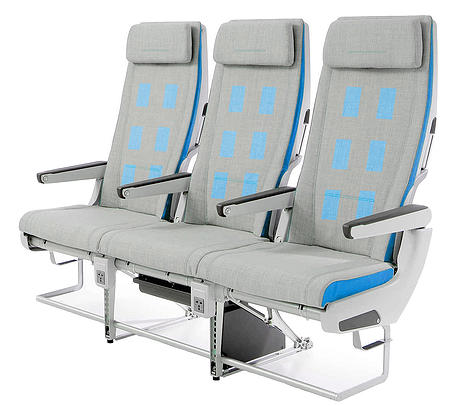Airplane Seat That Monitors Heart Rate Could Also Save Airlines Money
Share

Flight attendants of the future may be able to tell if passengers are feeling anxious or ill without so much as a glimpse of their facial expression or body language.
A group of industrial design engineering students at Delft University of Technology in The Netherlands have developed a concept that uses heart rate sensors embedded in an aircraft seat to discretely monitor the well-being of passengers. Called Flightbeat, the system is connected to an app that displays passenger moods at-a-glance with a color-coded seat map that points flight crew to unwell passengers.
Mirthe Monninkhove and Quirine van Walt Meijer, two of the students who developed Flightbeat, say the seats collect heart rate data with electrocardiograms. “The seat sensors are capable of reading the heart’s electrical impulses through clothing and are able to use one’s natural contact with the seat to maintain a reading,” they explain.
“To understand the emotional state that someone is in, Flightbeat uses software (proven by the Institute of HeartMath) that can translate a heart rhythm pattern into an emotion,” Monninkhove and van Walt Meijer told Inflight-Online.com. They also understand that some passengers may find collection of health data intrusive, so they’ve worked on incorporating the ability to accept or decline the service with the flip of a seat-embedded switch.
While there were consultations with Zodiac Aerospace and interviews with KLM flight crew, Monninkhove and van Walt Meijer say their concept was inspired by technology that Ford is developing for automobiles. They simply applied the idea to the airplane passenger experience.

This is not the first endeavor in the airline industry to take an interest in mood management: airBaltic lets passengers choose seatmates who match their chatty mood, Boeing and Airbus set the mood with cabin lighting, and British Airways’ Happiness Blanket measures mood through brain neurons. The latter, an example of mood-sensing technology, is a market that some Fortune 500 companies have invested millions of dollars in, including Coca-Cola.
But perhaps most similar to Flightbeat is the Apple Watch’s heart rate monitor that tracks the data during workouts as well as the number of calories burned in a day. Flightbeat’s ability to share heart rate information (or emotions) with others is akin to the Apple Watch’s ability to send heartbeats. As Apple says on its website, “it’s a simple and intimate way to tell someone how you feel.”
On the face of it, passenger mood tracking may seem like an industry-wide flight of fancy, but there’s an economical motivation, too, highlighted by one of the contributing students: “Did you know that airlines need to perform costly emergency landings due to passengers that do not inform cabin crew when they are feeling ill?” With effective mood tracking, airlines would have the ability to respond to health issues more proactively.


